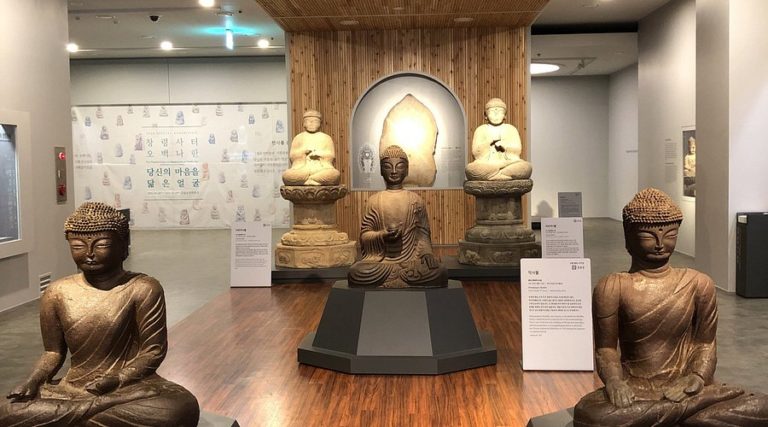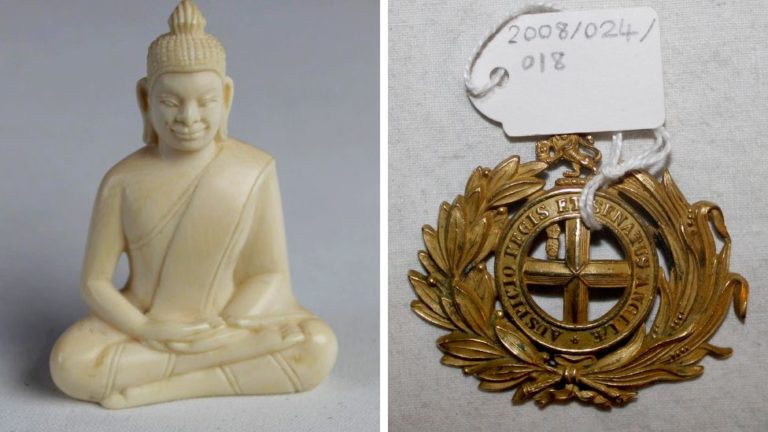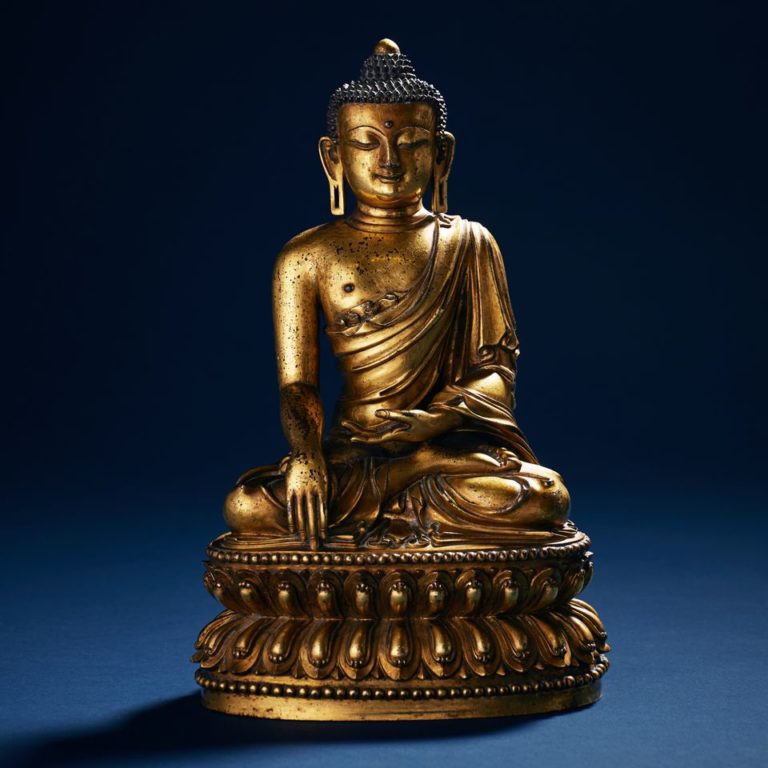The chariot has special importance in religious traditions in Thailand, especially those related to royal ceremonies and funerals.
Chariots figure prominently in South and Southeast Asian art and architectural decoration. Borrowed from the Sanskrit word ratha, the chariot is called rot in Thai and has special importance in religious traditions in Thailand, especially those related to royal ceremonies and funerals.


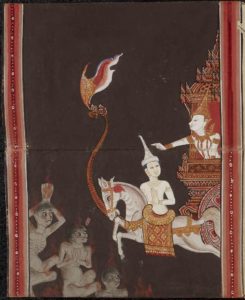
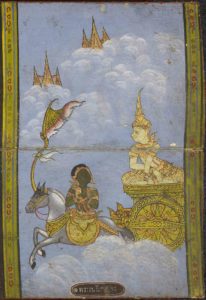
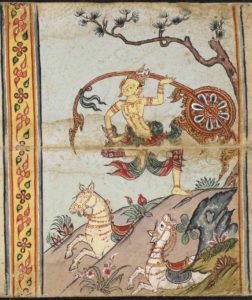



Impressive funeral chariots on four wheels have been reserved for kings and members of the royal family since the Ayutthaya period (1350-1767). Representing Mount Meru, the tip of which reaches the heavens according to the Thai Buddhist cosmology Traiphum, such ornate and lavishly gilded funeral chariots carried equally ornate urns containing the body of the deceased to the place of cremation.
Four-wheeled chariots or chariot-like vehicles are also used in ceremonies to parade Buddha statues during Songkran (New Year) processions, as shown in the image below.
The coloured drawing of a procession of a Buddha statue in southern Thailand was commissioned in 1824 by Captain James Low who was based at Penang as an officer of the English East India Company. It depicts a realistically drawn four-wheeled cart with a superstructure in the shape of a chariot on which a Buddha statue is paraded through town.
The vehicle is pulled by twelve men and accompanied by monks and charioteers seated next to the statue, with additional men, women and children in various ethnic attires seen in southern Thailand at the time.
Illustrations from Jatakas
Depictions of chariots with four wheels are rare in Thai manuscript paintings, however, two-wheeled chariots are frequently found in illustrations of scenes from the last ten Birth Tales of the Buddha (Jataka) in which the Bodhisatta, or Buddha-to-be, uses the vehicles. They can also be seen carrying Lord Sun and Lord Moon (below) in Thai Buddhist cosmologies.
While some European influence is obvious in the illustration of Lord Moon travelling in a chariot – for example in the simplified depiction of the wheels – the parts of a typical chariot in the Thai painting style are visible: the shaft with a decorative element in the shape of a naga (serpent) head and a banner, a highly decorative seat and a “tail” in a popular design called kranok.
Illustrations of scenes from the last ten Jataka were often added to a Buddhist text on the Great Perfections of the Buddha (Pali: Mahābuddhagunā) and collections of short extracts from the Pali Buddhist canon. Each of the last ten Jataka symbolises one of the Buddha’s Great Perfections.
These texts and images were often included in funeral and commemoration books made in folding book format (samut khoi) from mulberry paper in the fashion of the 18th and 19th centuries. In some of these Jataka stories chariots play an important role.
The painting above depicts a scene from the Nemi Jataka in the style of the late 18th century. Although the Nemi Jataka – which symbolises the perfection of resolution – is not included in this manuscript, the illustration appears in the context of the Mahābuddhagunā. Before a vibrant red background with floral decorations one can see King Nemi (Pali: Nimi) on a two-wheeled chariot pulled by two horses.
The wheel of the chariot has eight spokes, similar to the Dhammchakka whose spokes represent the Noble Eightfold Path, or Middle Way of Buddhism. On one horse kneels the divine charioteer Matali, who was sent from the heavenly realm of the god Indra to fetch Nemi for a visit to the Buddhist heavens and Nemi is seen here sitting in the carriage with a small pavilion-like superstructure. However, Nemi ordered Matali to first take him to the realms of hell – shown in the lower part of the picture – so he could teach his subjects about the horrors that await evildoers.
Although illustrations from the Jataka stories were relatively standardised in Thai manuscripts, there are always variations in the choice of colours and execution of details. The example above has a bright orange background with a deity hovering in the air.
Two horses are jumping over a skeleton, but apparently, the painter had some difficulty with perspective since the hind legs and tail of only one horse are visible. The chariot, harness and garments of the deity and charioteer are decorated with gold leaf.
During the 19th century, Thai painters seem to have enjoyed greater freedom to change details or to include their own ideas in their works. The illustration below depicts King Nemi on a glorious chariot that is pulled by only one horse.
For the background, the artist chose plain black, perhaps to highlight the fact that hell is a dark and hopeless place. An interesting element in this illustration is the charioteer’s conical white hat that is a traditional headgear worn by Thai nobility and royal Brahmins.
The features of horses appear more realistic in 19th-century illustrations, and often some Western influence is visible in the painting style. The picture below has a bright blue background with white clouds executed with simple brush strokes.
In the clouds, however, there are rooftops of heavenly palaces painted in the conventional Thai style. The chariot has no superstructure, but a wheel with a unique arrangement of spokes. Matali is depicted with green skin, possibly to emphasise the fact that he is a divine charioteer sent by the god Indra.
Another popular Jataka involving a chariot scene is the story of Prince Temiya, who as a child pretended to be “crippled and mute” so he would not have to become king, a role in which he might have to commit cruel acts leading to negative Karma. Ignorant Brahmins advised the king to send the apparently disabled child in a chariot to a graveyard and bury him there.
Upon arrival at the graveyard, the young prince lifted the chariot with one hand to show his power and capabilities. The scared charioteer released Temiya at once, realising he was a Bodhisatta, who then chose a life in meditation as an ascetic. Temiya lifting the chariot is the most popular scene from this Jataka, shown in the illustration below in 18th-century painting style with a distinctive rocky landscape and a crooked tree. The scene is made particularly lively by the shocked, escaping horses.
Another example of illustrating the Temiya Jataka, from a 19th-century manuscript, is shown below: the chariot waiting to pick up Prince Temiya, who sits motionless in meditation in front of a white stone building.
The charioteer is depicted with green skin, perhaps to indicate that he was under the influence of Indra’s deities when they guided him to steer the chariot carrying Temiya through the Gate of Victory instead of the Gate of Death. The heavily decorated chariot is also equipped with two monastic fans (Thai: talaphat) and a golden offering bowl.
The Vessantara Jataka, or Great Jataka, also contains important episodes involving chariots. It tells the story of the Buddha’s last existence before attaining Buddhahood as a generous prince who showed great compassion with the needy and the poor.
One well-known episode is depicted in the painting below, from a 19th-century manuscript: when Prince Vessantara was banished from the kingdom, he departed with his wife and children in a horse-driven chariot to set up a hermitage in the forest. However, on the way, some Brahmins asked for the horses which Vessantara gave them as a gift. Deities sent by the god Indra immediately transformed themselves into deer to replace the horses and pull the chariot.
Prince Vessantara is seen on the chariot which is only half shown. The realistically painted deer that is pulling the chariot has a golden harness, similar to those worn by the white horses which are being taken away by the Brahmins. This excellently executed illustration in 19th-century painting style has a calm light pink and light green background.
Another popular episode of the Vessantara Jataka is the return of the prince and his family to the royal palace, followed by his ascension to the throne. In contrast to the two-wheeled chariots in most Jataka illustrations, the scene below depicts an extravagantly decorated, glorious chariot with four wheels and a gilded pavilion-like superstructure in which Prince Vessantara is seated.
Also kneeling on the chariot are his wife Maddi with their two little children, as well as Prince Vessantara’s parents who welcomed them back into the palace. They are wearing golden headgear as a sign of royalty. At the back of the chariot one can see two gilded monastic fans. Below are four attendants in commoners’ outfits accompanying the procession.
Symbolic functions
In all these Jataka illustrations, chariots are more than just vehicles for transportation: they also fulfil symbolic functions. In the Nemi Jataka the chariot is a means to travel between the Three Worlds (Traiphum) of the Thai cosmos – human realm, heavens and hells.
In the story of Prince Temiya, the chariot is used to express the hero’s physical power and metaphorically his mental strength and moral stature as a Bodhisatta. The chariots that appear in the Vessantara Jataka are vehicles in which the Buddha-to-be goes through pivotal changes, from a life of luxury and convenience in the royal palace to a life of sacrifice and hardship as a hermit in the wilderness and then back from a hermit to becoming a righteous Buddhist king.

